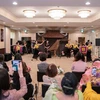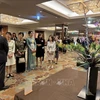The sight of young school-going gong players has become an everyday event in the Central Highlands these days, due to efforts to include this performing art in school curriculums.
M any schools in Dak Nong province have begun teaching students about the area's ancient gong culture in an effort to preserve and promote traditional values.
Students in boarding schools in Cu Jut, Krong No, Dak Mil and Dak R'lap, as well as in the Dak Song district and Gia Nghia town, appear quite interested in learning to play gongs and stage gong performances, apart from their regular studies.
Eventually, many schools have established gong troupes of different ages, together with gong clubs, with gong sets provided by the provincial Department of Culture, Sports and Tourism.
Dieu Lam Doanh, a 12th grader at N'Trang Long boarding school in Gia Nghia town, said, "Although I was born in the land of gongs, I did not know how to play it. Now I do, fortunately."
"The students in our school understand that we have to respect, conserve and keep alive the fine tradition of playing gongs. Also, playing the gongs helps us relax and strengthens our friendships after intense class room studies," Doanh added.
The students are taught how to beat the gong and perform by local senior artists, beginning at the age of 11. The local artists pass on their knowledge to the younger generation.
Artist H'Nhum of the Dak N'drung Commune, who is training boarding school pupils in Dak Song District, said "Many of the young generation were not interested in gongs, and they were unable to play or feel the rhythm of the instruments. Since I was invited to give lectures on this art, I have found out that students are enthusiastic and want to learn how to play the gong. Many of them are quick and excellent learners. This is really encouraging and needs to be promoted."
The director of the Dak Nong province's Department of Culture, Sports and Tourism, To Dinh Tuan, agreed with H'Nhum and added that the gong's popularity among students will go a long way to preserving the local culture.
"The province also encourages schools to introduce other genres of arts, such as folk dances and songs, as extra-curricular activities," Tuan remarked.
Dak Nong province is not the lone region where students are being taught about their traditional arts.
"This subject has received an enthusiastic response from many students," said Nguyen Van Hung, the principal of A Dok elementary school in Gia Lai province's Dak Doa district.
According to Hung, gongs were first introduced in the A Dok school about 12 years ago by a teacher of the Bahnar ethnic group, when he became worried that gongs were vanishing in local communities.
"YBRenh was an able teacher and a talented gong artist. He "pushed" the school to train third and fifth graders in an effort to raise awareness about traditional arts among the young generation and also to preserve and bring gong playing into the limelight," Hung said.
YBRenh, who has now retired, also donated his family's gong sets to the school.
In the beginning, when he started his mission, he played the gongs during the lunch hour to gauge the students' attitudes.
Playing in front of a handful of students during the first days, YBRenh also talked about the value of gongs and showed the "audience" how to beat the right musical note, which depends on the size of the gongs. Day after day, his performances lured an increasing number of students, which led to the promotion and inclusion of the study of gongs in the school.
He also instructed school girls to perform the xoang dance of the Bahnar people.
The gong experiment, together with the emphasis on other traditional art forms in A Dok school, was such a success that it became the model for other schools in the province. In the Dak Doa district alone, there are eight elementary schools that are developing their own gong and xoang dance ensembles.
The gongs are intertwined with the daily life of each individual, family and community in the region. It is through the beating of the gongs and its sounds that the local people pray for their souls and sends their wishes to their deities and ancestors, as well as pray for good harvests, health and happiness.
The cultural space of Central Highlands Gongs, which covers the five provinces of Kon Tum, Gia Lai, Dak Lak, Dak Nong and Lam Dong, was recognised as a Masterpiece of the Oral and an Intangible Cultural Heritage of Humanity by UNESCO in 2005.-VNA
M any schools in Dak Nong province have begun teaching students about the area's ancient gong culture in an effort to preserve and promote traditional values.
Students in boarding schools in Cu Jut, Krong No, Dak Mil and Dak R'lap, as well as in the Dak Song district and Gia Nghia town, appear quite interested in learning to play gongs and stage gong performances, apart from their regular studies.
Eventually, many schools have established gong troupes of different ages, together with gong clubs, with gong sets provided by the provincial Department of Culture, Sports and Tourism.
Dieu Lam Doanh, a 12th grader at N'Trang Long boarding school in Gia Nghia town, said, "Although I was born in the land of gongs, I did not know how to play it. Now I do, fortunately."
"The students in our school understand that we have to respect, conserve and keep alive the fine tradition of playing gongs. Also, playing the gongs helps us relax and strengthens our friendships after intense class room studies," Doanh added.
The students are taught how to beat the gong and perform by local senior artists, beginning at the age of 11. The local artists pass on their knowledge to the younger generation.
Artist H'Nhum of the Dak N'drung Commune, who is training boarding school pupils in Dak Song District, said "Many of the young generation were not interested in gongs, and they were unable to play or feel the rhythm of the instruments. Since I was invited to give lectures on this art, I have found out that students are enthusiastic and want to learn how to play the gong. Many of them are quick and excellent learners. This is really encouraging and needs to be promoted."
The director of the Dak Nong province's Department of Culture, Sports and Tourism, To Dinh Tuan, agreed with H'Nhum and added that the gong's popularity among students will go a long way to preserving the local culture.
"The province also encourages schools to introduce other genres of arts, such as folk dances and songs, as extra-curricular activities," Tuan remarked.
Dak Nong province is not the lone region where students are being taught about their traditional arts.
"This subject has received an enthusiastic response from many students," said Nguyen Van Hung, the principal of A Dok elementary school in Gia Lai province's Dak Doa district.
According to Hung, gongs were first introduced in the A Dok school about 12 years ago by a teacher of the Bahnar ethnic group, when he became worried that gongs were vanishing in local communities.
"YBRenh was an able teacher and a talented gong artist. He "pushed" the school to train third and fifth graders in an effort to raise awareness about traditional arts among the young generation and also to preserve and bring gong playing into the limelight," Hung said.
YBRenh, who has now retired, also donated his family's gong sets to the school.
In the beginning, when he started his mission, he played the gongs during the lunch hour to gauge the students' attitudes.
Playing in front of a handful of students during the first days, YBRenh also talked about the value of gongs and showed the "audience" how to beat the right musical note, which depends on the size of the gongs. Day after day, his performances lured an increasing number of students, which led to the promotion and inclusion of the study of gongs in the school.
He also instructed school girls to perform the xoang dance of the Bahnar people.
The gong experiment, together with the emphasis on other traditional art forms in A Dok school, was such a success that it became the model for other schools in the province. In the Dak Doa district alone, there are eight elementary schools that are developing their own gong and xoang dance ensembles.
The gongs are intertwined with the daily life of each individual, family and community in the region. It is through the beating of the gongs and its sounds that the local people pray for their souls and sends their wishes to their deities and ancestors, as well as pray for good harvests, health and happiness.
The cultural space of Central Highlands Gongs, which covers the five provinces of Kon Tum, Gia Lai, Dak Lak, Dak Nong and Lam Dong, was recognised as a Masterpiece of the Oral and an Intangible Cultural Heritage of Humanity by UNESCO in 2005.-VNA



















